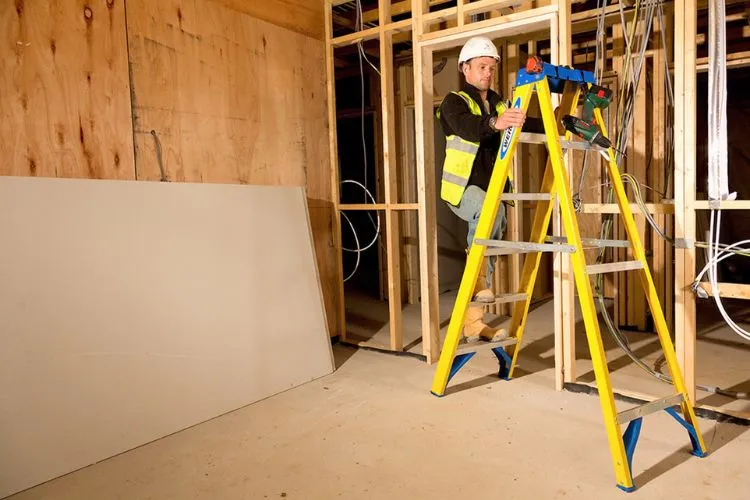Navigating the rungs of a ladder might seem straightforward, but statistics paint a stark picture of the risks involved. According to the World Health Organization, falls are the second leading cause of accidental or unintentional injury deaths worldwide.
Among those, ladder-related mishaps are prominently featured. That’s why it becomes important to learn how to improve ladder safety to avoid any unwanted accidents.
In the US alone, more than 500,000 people suffer ladder-related injuries annually, and approximately 300 prove fatal. This underlines a critical need: improving ladder safety is not just about compliance, it’s about preserving lives.

How can I improve my ladder safety?
The foundation of ladder safety begins with selecting the appropriate ladder for the job. From step ladders, designed for height within an arm’s reach, to extension ladders for scaling new heights, each type has a specific purpose.
Mindful selection, considering weight capacity and length, is pivotal. A ladder that is too short tempts dangerous overreaching, while one that is too long can be unwieldy and unstable.
The material of the ladder also matters. For instance, fiberglass ladders, while heavier and sometimes more expensive than aluminum ones, provide the benefit of being non-conductive, making them safer for electrical work.
Pre-Use Inspection
Before each ascent, a thorough inspection of the ladder is critical. All components—rungs, side rails, locks, and spreaders—must be scrutinized for damage or wear. Disregard for this step is a primary cause of ladder-related accidents. Regular maintenance checks, coupled with immediate repairs or replacements of faulty parts, are non-negotiables in the realm of ladder safety.
Proper Ladder Setup
Poor setup is a prelude to peril. The mantra is straightforward: a secure surface and stable positioning. Before the first upward step, ensure that the ladder’s feet are firmly planted and that it is not leaning on an unstable surface.
Stability often hinges on a simple, yet vital rule—the 4-to-1 ratio, which means for every four feet of ladder height, the base should be one foot away from the wall. This angle guarantees both stability and reduces strain on the structure of the ladder.
Moreover, techniques to secure the ladder in place can vary, but at the core is ensuring that the ladder won’t slip or shift. This could involve tying it off at the top, securing its base, or even having a spotter when possible.
Safe Ladder Usage
When ascending or descending, the ‘three-point contact rule‘ should be upheld: two hands and one foot, or two feet and one hand must be in contact with the ladder at all times.
Overreaching or leaning too far to either side can unbalance a ladder and should be avoided. Distribute weight evenly and keep the center of your body within the side rails. Lastly, appropriate footwear—a necessity often overlooked—ensures good grip and stability.
Understanding Ladder Load Capacity
Every ladder comes with a duty rating, which needs to be respected. Exceeding the weight limit—or duty rating—puts unnecessary stress on the ladder, potentially leading to failure and injury.
This weight includes not only the person but also any tools or materials they are carrying. Heavier individuals should opt for a Type IA or IAA ladder, which hold 300 and 375 pounds respectively.

Ladder Safety Training
While many consider ladder use to be guided by common sense, formal training programs provided by OSHA (Occupational Safety and Health Administration) or other reputable institutions can impart critical knowledge and tips that might not be as obvious. In today’s digital age, numerous online resources also provide valuable ladder safety training, offering the convenience of self-paced learning.
Avoiding Common Mistakes
Many ladder accidents stem from misuse such as standing on the top rung, using ladders as makeshift bridges, or not locking the brace in place. It takes only one misstep to turn a routine job into a disaster.
Understanding what not to do is as crucial as knowing the correct practices. Emergency procedures are often overlooked during planning, yet being prepared with a first aid kit and a plan can make a significant difference in the event of an incident.
Special Considerations
Electric shock is a severe hazard associated with ladders, particularly when they’re made of conductive materials like aluminum. Always use a non-conductive ladder when working near power lines or electrical equipment.
Additionally, indoor and outdoor ladder use can bring different challenges; for instance, outdoor use requires vigilance about weather conditions, like wind or rain, that can affect safety.
Storing and Transporting Ladders
A meticulous craft extends beyond use to storage and transport. Ladders should be stored horizontally, supported along their length, to prevent sagging or warping. When transporting, ensure the ladder is tied down securely, without overextending beyond the vehicle’s length unless appropriately flagged.
Frequently Asked Questions (FAQs)
How often should I inspect my ladder?
It’s recommended to inspect your ladder before each use to ensure there are no visible defects or wear that could compromise its safety.
What is the safest angle to place a ladder?
The optimal angle for a straight or extension ladder is to follow the 4-to-1 ratio, with the base placed one foot away from the wall for every four feet of height to where the ladder rests against the building.
Can I use a metal ladder for electrical work?
It’s strongly advised not to use metal ladders for electrical work because they conduct electricity. Instead, use a wooden or fiberglass ladder that is non-conductive to reduce the risk of electric shock.
Conclusion:
Ladder safety is not an innate skill, but rather a learned one, reinforced by constant practice and mindfulness. From the initial choice to the moment a ladder is stowed away, each step must be taken with deliberation and caution.
Whether you’re reaching for the roof or simply changing a lightbulb, remember: the highest rung of safety is only reached through the steps of prevention.


